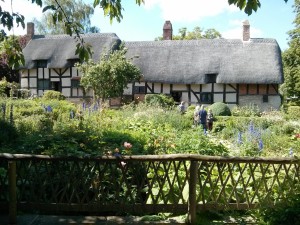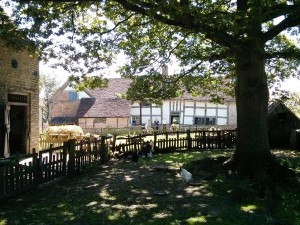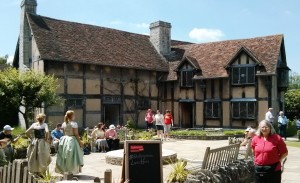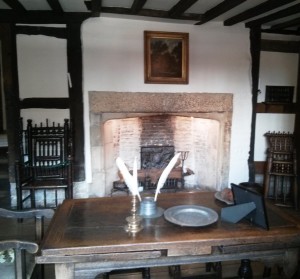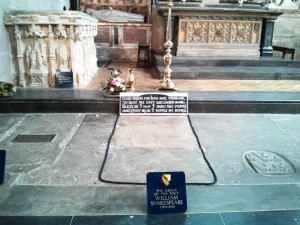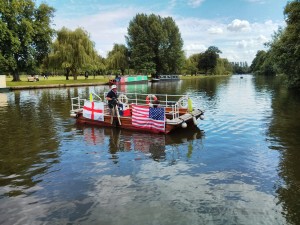Thursday – Friday, June 12 -13
For most of his career, Shakespeare lived in London while his wife and children lived in S-U-A (Stratford-Upon-Avon). Shakespeare visited his family once or twice a year. It took him 4 days to make the trip. We did it in two hours. Of course, his trip included an overnight stop at Cambridge University, where rumor has it he had a mistress. (Or was it Oxford University? I get the two mixed up.) We woke up early as usual. The train didn’t leave until Noon (a fair restriction in exchange for a £6 fare). We didn’t have anything planned (everything being closed until 10 in any event). We decided it was as easy to wait at the train station as to wait in the hotel room. It turns out our train station was within a block of 221B Baker Street. Yes, there is a Victorian house at that address. Yes, there is a museum in the house. No, we did not go to the Sherlock Holmes museum. If you look at the reviews on-line, you probably wouldn’t go either. It’s good to have a Kindle or iPad with a few books on it.
After we arrived at S-U-A and checked into our guest house, we went to visit Anne Hathaway’s cottage. (Anne was Shakespeare’s wife. This house was where she grew up.) It was our first visit to a Tudor-era location. While there was a lot of similarity to Colonial-era sites we have seen before, the 200-year difference was obvious. We learned that a common way for middle-class families to build a house was to build with two rooms separated by a breezeway. This separated the living quarters from the kitchen. The house was built without fireplaces. Fires were built in the middle of the room. It turns out a good thatch roof blocked the rain while letting the smoke out. When children came along, one could build a ledge (a half-floor – similar to a loft). In the mean time, one could start adding a couple of chimneys. Once the chimneys were in, one could add the second story under the existing roof. Only the very rich had fire places on the second floor. It was a pretty good system.
They roll the sidewalks up early in S-U-A. We’re not big for spending much time in a pub, so we picked up a bottle of wine and went to our room for the night. The next day, we visited Mary Arden’s Farm (where Shakespeare spent a lot of time), Shakespeare’s birth place, a couple of houses his children owned, and Trinity Church where he is buried. We were amazed that so many Tudor buildings associated with Shakespeare are still in existence.
The difference in wealth between Shakespeare as a child (his parents were middle-class) and Shakespeare at the height of his fame was obvious and astounding. The very wealthy had 10-foot ceilings, interior doors so tall that one could walk through without stooping, wide and straight staircases, and painted canvas wall coverings (they look like tapistries when the neighbors look through the windows). The last house we saw was the first house in S-U-A that was originally built with glass windows. (The glass was imported from Italy.) Shakespeare’s grandson lived at the last house we visited, which was on the way from Shakespeare’s house to Church. We certainly stood on the floor Shakespeare stood on and saw the fireplace he sat at while visiting. (The pic is labeled “Shakespeare’s Hearth”, even though it was technically his daughter’s hearth.)
Did you know … in addition to meatless Fridays, Tudor England had two additional days most weeks where meat was not eaten? By this time, the last vestiges of Catholicism were gone. But it was important that England have a ready supply of seafaring men. So they needed a large fishing fleet. So they needed to create a large demand for fish. Did you know … the transition from feudal to modern society happened in just 50 years. It all happened within the lifetime of Shakespeare’s parents.
Shakespeare would normally have gone to the university (was it Oxford or Cambridge?). He didn’t because of his father ran into financial difficulties. Instead, after going to grammar school where he learned Latin and Greek, he was self-educated by reading books. He couldn’t afford books, of course. He borrowed them, eventually becoming good friends with a few book stall owners in London and using them as a library. He was quite an entrepreneur. He and 5 fellow-actors formed the company that built the Globe theatre. To be successful, it wasn’t enough to have enormous talent. They also needed dependable place to perform that was near London but outside the city limits (to escape control of the arbitrary London laws). As you can tell, having read a little about Shakespeare added enormously to the enjoyment of this part of the trip.
We had a little time late in the afternoon, so we took a short cruise on the canal, then went back to our room to watch the Star Trek movie “The Wrath of Kahn”. Talk about high culture — it doesn’t get any better than this. The weather continues to be delightful, and the prices in S-U-A are much more reasonable than in London. When we’re on the train, we buy those horrid pre-made sandwiches the English are so fond of. But we are also finding eateries where the food is quite good.
S-U-A is where I bought my favorite coffee cup of the trip. The printing consists of some of Shakespeare’s better insults, which is pretty cool. It is marketed by the Philosopher’s Guild. If you turn the cup upside-down, it says “For best results, use other side”. They also have a very clever training video at www.philosophersguild.com/PAKE .

